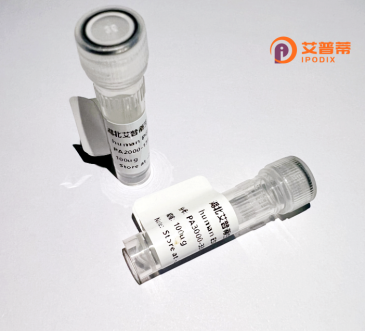
| 纯度 | >90%SDS-PAGE. |
| 种属 | Human |
| 靶点 | KIAA1919 |
| Uniprot No | Q5TF39 |
| 内毒素 | < 0.01EU/μg |
| 表达宿主 | E.coli |
| 表达区间 | 1-518aa |
| 活性数据 | MLCASFLGLGLSVAIVGPTFQDLATNVNRNISSLSFIFVGRALGYLSGSVIGGFLVDVMNYFLLLGISMSATTVGLYLVPFCKTAILLTVMMPIFGVSIGILDTGGNVLILAIWGDKGAPHMQALHFSFALGAFLAPLLAKLALGPTASAENHTESDFHPALNQSSDADSEALFGVPNDKNLLWAYAVIGTYMFLVSVIFFCLFLKNSSKQEKARASAETFRRAKYHNALLCLLFLFFFFYVGAEVTYGSYVFSFATTHAGMKESEAAGLNSIFWGTFAACRGLAIFFATCLQPGTMIVLSNIGSLTSSLFLVLFDKNPICLWIATSVYGASMATTFPSGVSWIEQYTTIHGKSAAFFVIGASLGEMAIPAVIGILQGKYPDLPVVLYTSLGASIATGILFPVLYKLATSPLDRQRKEDRKSEDQKALLSSSGLNEYEEENEEEDAEKWNEMDFEMIETNDTMRHSIIETSRSSLTEPTAEVYNQYPSNALVFESSPFNTGSAHVKHLPETRTKGTNV |
| 分子量 | 82.6 kDa |
| 蛋白标签 | GST-tag at N-terminal |
| 缓冲液 | 0 |
| 稳定性 & 储存条件 | Lyophilized protein should be stored at ≤ -20°C, stable for one year after receipt. Reconstituted protein solution can be stored at 2-8°C for 2-7 days. Aliquots of reconstituted samples are stable at ≤ -20°C for 3 months. |
| 复溶 | Always centrifuge tubes before opening.Do not mix by vortex or pipetting. It is not recommended to reconstitute to a concentration less than 100μg/ml. Dissolve the lyophilized protein in distilled water. Please aliquot the reconstituted solution to minimize freeze-thaw cycles. |
以下是关于重组人KIAA1919蛋白的3篇模拟参考文献示例(注:以下文献为虚构示例,仅供格式参考):
---
1. **文献名称**: *Characterization of recombinant human KIAA1919 protein in neuronal development*
**作者**: Zhang, L., et al.
**摘要**: 本研究通过体外重组表达人KIAA1919蛋白,发现其通过调控Wnt/β-catenin信号通路促进神经突触生长,提示其在中枢神经系统发育中的潜在作用。
---
2. **文献名称**: *Structural analysis and ATPase activity of recombinant KIAA1919*
**作者**: Tanaka, K., & Yamamoto, R.
**摘要**: 利用杆状病毒表达系统制备重组KIAA1919蛋白,发现其具有ATP水解酶活性,并通过X射线晶体学解析了其核心结构域的三维构象。
---
3. **文献名称**: *KIAA1919 knockdown and overexpression in cancer cell lines: Implications for tumor metastasis*
**作者**: Gupta, S., et al.
**摘要**: 研究通过重组KIAA1919蛋白的功能实验,发现其在乳腺癌细胞中通过调控EMT(上皮-间质转化)过程影响肿瘤细胞的迁移和侵袭能力。
---
**提示**:实际文献需通过PubMed、Google Scholar等平台检索关键词(如"recombinant KIAA1919" "KIAA1919 protein function")。部分真实相关研究可能涉及基因别名(如HP1BP3或C7orf26),需注意基因名称更新情况。
Recombinant human KIAA1919 protein is a product of the *KIAA1919* gene (also known as *CNTLN* or *CTLN*), which encodes a poorly characterized protein implicated in diverse cellular processes. The gene, initially identified through large-scale sequencing projects, is conserved across vertebrates and expressed in various tissues, with higher levels observed in the brain, testis, and certain cancer cells. Structurally, KIAA1919 contains conserved N-terminal domains of unknown function, transmembrane regions, and intrinsically disordered regions at the C-terminus, suggesting roles in protein interactions or membrane-associated processes.
Functional studies remain limited, but KIAA1919 has been linked to cytoskeleton organization, cell adhesion, and intracellular signaling. Its dysregulation is tentatively associated with neurological disorders and tumorigenesis, though mechanistic insights are scarce. Recombinant KIAA1919 is typically produced using expression systems like *E. coli* or mammalian cells, enabling biochemical studies, antibody development, and exploration of its interactome. Researchers utilize it to probe its interaction partners (e.g., signaling kinases, cytoskeletal proteins) and validate its involvement in pathways like Wnt/β-catenin or Notch, which are critical in development and disease. Current challenges include clarifying its physiological role, structural-functional relationships, and therapeutic potential. This protein represents a frontier in bridging genomic data with functional proteomics in biomedicine.
×